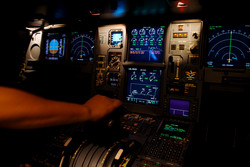Remote phosphor debuts in avionics displays
Current avionics displays use liquid crystal display (LCD) technology that mainly consists of two parts: a liquid crystal glass and a backlight (LED) creating all the necessary light. However, nearly every LCD display suffers from uniformity issues. With EU funding of DERPHOSA (Technology development of remote phosphor for avionic cockpit displays), four European companies joined forces to develop a new backlight concept based on remote phosphor, offering a simpler solution with a more stable colour yield. The advanced remote phosphor backlight concept is an evolution of the current triple-colour or white LED backlights. A blue LED illuminates a layer of fluorescent phosphor, converting the blue wavelength to very stable, customised white light. The phosphor is layered onto a substrate separate from the LED chip. Reaction losses between phosphors and the LED chip are thus minimised, leading to higher light output and improved colour performance. By eliminating the use of multiple light sources and complex electronics and control software to correct for colour differences, this technology significantly simplifies the LCD backlight unit. It also offers high reliability and reduced maintenance costs. Project efforts were mainly devoted to adapting the fluorescent phosphors to the wavelength of the blue pump light source and tuning them to the LCD colour filter. Researchers implemented the remote phosphor backlight concept for both direct-lit and edge-lit applications. The new displays scored well during validation testing at an altitude of 10 km and with bright sunlight, offering better contrast and greater clarity than the current displays. In addition to better image quality, the innovative DERPHOSA solution combines higher energy efficiency and lower weight compared to the current triple-colour or white LED backlights. Project results were disseminated through the project website, at conferences and in newsletters. You can view the project video here.
Keywords
Remote phosphor, avionics, LED, aircraft, cockpit displays, LCD, backlight

